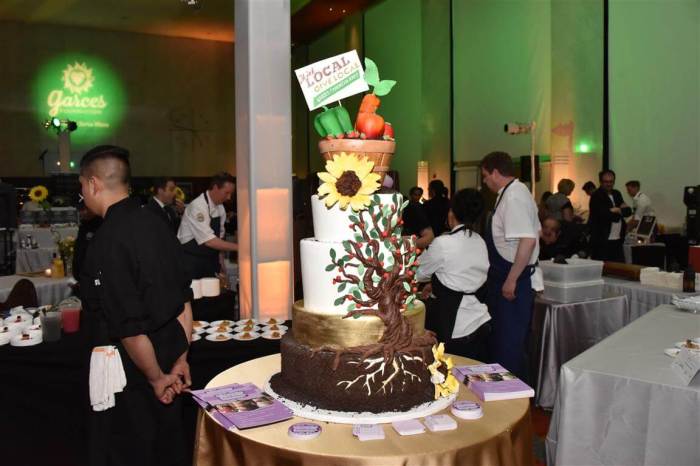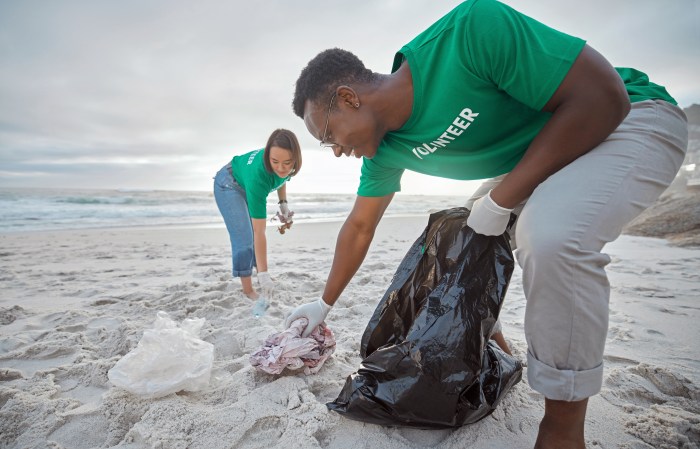 Sean Sheridan holds an enlarged photo of BayHouse taken the day after Sandy hit.
Sean Sheridan holds an enlarged photo of BayHouse taken the day after Sandy hit.
Credit: Lenyon Whitaker/Metro
Far away from the island of Manhattan, sand-lined roads and cozy Cape Cod houses make it easy to forget that the Rockaway Peninsula is also part of New York City. Here, the ghost of Hurricane Sandy is palpable. In Breezy Point, one of the hardest hit neighborhoods, only about half of the residents have returned to their homes. Many houses are still in obvious disrepair, and wooden signs shaped like stars bear messages like “God Bless Breezy Point.”
The vantage point of the BayHouse Restaurant in Breezy Point, Queens, offers magnificent, panoramic views sweeping from the Verrazano Bridge past One World Trade Center. Southern Brooklyn’s beaches lie between Breezy Point and Lower Manhattan, creating the illusion that the skyline rests on a sand bar — New York City looks like a modern day Oz from here.
But there used to be a lot more to see. Only the bare, pointy piles are left of a former pier, and the BayHouse is just a shell of its old self. There is no vestige of the deck where customers would stretch out and tan while they knocked back a few beers and snacked on burgers and wings. The BayHouse used to be a hub for Breezy Point residents: The former space was a charming, white beachfront tavern with retractable purple awnings that provided shade from the summer sun. Both the deck and the indoor space were popular for customers who came with their children to listen to live music and enjoy the summer breeze.
Sean Sheridan, the owner, built a temporary space to set up shop this summer. The interior is decorated, much like the original BayHouse, with tchotchkes like mounted sailfishes and nautical flags. Sheridan did an impressive job building the temporary space; he installed windows, floors and a bar, but still, the makeshift restaurant is drafty and the tarp roof rattles as the bay winds thrash against it. Sheridan is shutting down the restaurant for the season, just one year after Hurricane Sandy wrecked the original building, but the BayHouse used to operate year-round.
Sheridan remembers that high tide on the day Hurricane Sandy hit around 9 p.m. last year on Oct. 29. At just 5 p.m., the water was already pouring through the door of his restaurant.
“You could see how quickly it was approaching and that you had to get out of there in 20 minutes,” he told Metro. Sheridan left the restaurant to go to his Breezy Point home a mile away and walked back across the beach the next afternoon.
“I saw all of the devastation of the other homes and businesses on my way,” he said. “My restaurant has been open for 12 years. I basically renovated the whole place when I took it over 12 years ago and it was a labor of love. It was a very tough thing to look at.”
Photos of the restaurant after the hurricane reveal a structure that has been totaled: So much of the walls are gone that the building resembles an open-air garage more than it does a restaurant. In the photos, wrecked bits of the restaurant are strewn across the sand and the beams of the building look like they’re going to collapse.
“It was horrible,” said a former BayHouse server who declined to give her name. “It was devastating. There was nothing left. This was like home – I worked here for nine years.”
She had to find a new job to support her four children after the hurricane.
Sheridan found that most of the items in his restaurant had been destroyed if they hadn’t been washed away, though a few items were salvageable, including a stained-glass American flag given to him by a regular customer.
“It was hanging in one of the windows and lasted through the storm,” Sheridan said. “It was just a beautiful thing to see that it was still standing.”
Still, Sheridan had to comb through the wreckage and throw out most of the items. “You’d look at certain things, like high chairs, and think about how many kids had sat in there,” he said. “Or you’d throw out pictures that were destroyed and so many good friends and customers were in those pictures, and those can’t be replaced. You’ll always have the memories, but it’s nice to be able to point them out to people.”
Even though Sandy had completely stamped out the restaurant, Sheridan was always determined to get the BayHouse back up and running. “We knew we had to get back both for ourselves and for the people of the community and the Rockaways,” he said. But Sheridan had to prepare his insurance claims and communicate with his insurance companies before tearing down the restaurant in late April, after which he applied for permits to open a temporary space. He knew there wasn’t enough time to open a permanent restaurant for the summer, the BayHouse’s busiest time. Sheridan placed a high priority on opening this past summer since it’s his business’s most important season. This meant it would not be possible to start planning and building the permanent structure until after he closed the summer pop-up BayHouse.
Sheridan spent a month building a temporary space himself and reopened the restaurant in June, much to the delight of his regulars. He proudly showed off the efficient use of his space, with two small fryers in the back, an ice machine that doubled as a beer cooler and a grill just outside the back door.
Sheridan’s cheery disposition belies the obstacles he has faced this past year. He had to let go of his employees, some of whom had worked for him for nine years, and he himself has not earned any income in the past year. He said he has been covering his expenses mainly out of pocket after he was rejected by government programs designed to aid businesses hurt by Hurricane Sandy. He said he applied for loans through the city, but NYC Small Business Services told him they did not believe he could pay back the loan in the allotted time after looking at the BayHouse’s finances. Sheridan did receive a grant from the National Grid, but he won’t receive it until he starts rebuilding the permanent space.
In spite of the lack of city funding, Sheridan was quick to praise the Bloomberg administration and its initiatives in helping Sandy victims: The city passed a bill in August requiring the Office of Emergency Management to help small businesses devise recovery plans. Sheridan pointed out that the city was extremely useful in helping him open his temporary space.
He vowed long ago not to give up on his restaurant. “After dealing with the initial pain, we knew we had to come back,” he said.
He is eager to tear down the temporary building and rebuild a permanent BayHouse. He is working with an architect and hopes to submit the plans to the Department of Buildings soon and set a foundation for the restaurant in December.
A new start for Thai Rock
Six miles and seemingly a world away, wafts of kaffir lime, lemongrass and cilantro travel down the warm air in the front corridor of Thai Rock restaurant in Far Rockaway. The hallway leads into an airy waterfront dining room with huge windows facing the bay, a splashy dragon boat and a deck adorned with lanterns. On Thursday evening, the dining room was half full with colleagues sharing after-work appetizers and cocktails and families eating an early dinner. In the corner, a band set up its equipment for a live performance later in the night.
The brand new hardwood floors, fresh paint and Thai artwork bear no traces of Sandy, but Thai Rock was ravaged by the hurricane and only opened its indoor space in mid-October this year.
“There was no floor here,” said Robert Kaskel, owner of Thai Rock. “You’d just go right into the bay. In some parts, where the wall meets the floor, it was just air. It was sort of like a house of cards.”
Kaskel said he knew disaster was imminent when he saw that even at low tide, the water was already close to the surface of his deck.
“The water, even on a high tide, doesn’t even get close to that,” he said. “At the height of Irene was where the water was during the low leading up to Sandy. I could tell around 2 that afternoon that there was something really bad happening.”
He and his family evacuated to a hotel near LaGuardia Airport and returned to Far Rockaway the next day to find both their home and their business destroyed.
“We saw that [Thai Rock] was pretty much upside down,” said Kaskel. “It was like everything was tossed up and nothing landed on its feet. Beer coolers with hundreds of bottles were thrown around like they were nothing. It was mayhem.”
But the real danger was what they couldn’t see: The water had seeped through and damaged the inside of the structure of the floors and walls.
“Once you peeled the flooring away, you could see areas where you could stick your foot through the whole subfloor,” Kaskel said.
His contractor told him he would have to rebuild everything except for the roof and expressed concern when he learned Kaskel and his family were living upstairs in the building.
“He said, ‘You guys are living here and there’s nothing holding up these walls or this roof. It’s amazing it didn’t fall through into the water,'” Kaskel said. His contractor put in a few braces so the building wouldn’t collapse.
Before Kaskel could come up with a recovery plan, his landlord told him he had someone interested in buying the property and that he would sell it if Kaskel didn’t buy it – at a pre-Sandy price, he said. He bought the property on Christmas Eve of 2012, and then started gathering funds so he could rebuild.
“Everything else is easy, but money, money, money – that was the most difficult part,” he said. “Everything you’re looking at comes from a tremendous amount of stress and begging and borrowing, and not from any single source.”
Kaskel added that he could have opened months earlier if he had gotten the funds and he said he feels angry and disappointed that the government denied him a Small Business Association Disaster Loan. He got up to the final step of approval for the loan before Small Business Services rejected his loan application on grounds stemming from the fact that he had created a new company after Hurricane Sandy called Thai Rock Holdings. Kaskel said that since the company opened after Sandy and the building was owned by this “new” company, he was ultimately turned down for the loan.
“That was the only source of funding that I had available and they denied me,” he said. Kaskel’s wife, Metta, is the manager at Thai Rock so neither of them were bringing home any income. Kaskel ended up taking out a second mortgage on the property and his contractor agreed to work out a long-term payment plan for him.
Piece by piece, Kaskel’s contractor started ripping down and rebuilding Thai Rock in March. By May, the restaurant was able to open its outdoor deck, where it served a limited menu of grilled food and rented out water sports equipment. Finally, in mid-October, Kaskel was able to fully open his restaurant. “It was amazing,” he said. “It could bring me to tears. Seeing the water from these windows – I realized, ‘Wow, I am back. This is so excellent.'”
His wife Metta said, “It was beautiful. I’m so happy. I love working and I was so lazy and bored when the restaurant was closed.”
But Kaskel’s struggle is far from over. “I’m worried that I need strong enough financial hands to keep it open,” he explained. “Now, I have a place that’s beautiful and humming again. I spent a year struggling to get to this point and now I’m more afraid than ever that it can be taken away because I have so much more invested in it.”
Kaskel said that his main focus right now is to make it through the winter, the toughest part of the year for a restaurateur in Far Rockaway. He said he feels confident the business will do well next summer. Though Kaskel is plagued by financial worries, he beams with pride when he talks about the new Thai Rock. “It makes me so happy inside,” he said. “I’ve done something that people really like and appreciate.”
Follow Andrea Park on Twitter: @andreapark

















